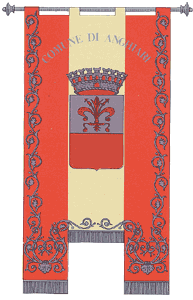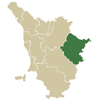|
 Inhabitants
in 1991 : 5,877 Inhabitants
in 1991 : 5,877
 The
Municipal territory of Anghiari extends from the slopes of the Catanaia
Alps to the plains of the Val Tiberina for 130,58 square kilometres, for
the most part hilly. A staging post where the road from Romagne led into
the Casentino before the opening of the easier route of the Via dello
Scopetone at the end of the 1500s. At first it was a feudal centre,
therefore a free municipality and then became a Vicariate : capital
of the municipality by decree of Pietro Leopoldo in 1776. The
Municipal territory of Anghiari extends from the slopes of the Catanaia
Alps to the plains of the Val Tiberina for 130,58 square kilometres, for
the most part hilly. A staging post where the road from Romagne led into
the Casentino before the opening of the easier route of the Via dello
Scopetone at the end of the 1500s. At first it was a feudal centre,
therefore a free municipality and then became a Vicariate : capital
of the municipality by decree of Pietro Leopoldo in 1776.
The castle of Anghiari, noted in documents of the X and XI century as
“castrum Anulare” or “Anglare”, was originally
the feudal of Count Galbino, a branch of the family of Barbolani di Montauto.
Donated by them in 1104 to the Hermitage of Camaldoli, under
the jurisdiction of the monks in was able to develop, enjoying a certain
liberty provided by the municipal by-laws of the XIII century. This sort
of autonomy ceased in 1322 when the Tarlati di Pietramala became
Lords of Anghiari, and remained thus until 1384 (with the exception
of the years 1339-1352 when the dominion passed to the municipal of Perugia).
Eventually in 1385 Anghiari come under the protection of Firenze who
chose it as See of a Vicariate comprising nearly the whole of the territory
which was previously feudal to the Tarlati ; and in 1440 at Anghiari
there was the pitched battle which sanctioned definitively the possession
by Firenze of all the Casentino and the Toscana Val Tiberina, and the
end of the Visconti threats to the region. Under the dominion of the
Medici it realised a significant economic and cultural revival,
competing with Borgo San Sepolcro for the supremacy of the most important
centre of the Toscan Val Tiberina.
Places to visit
Santa Maria delle Grazie XVIII century Provost ‘s
house , the interior is rich with valuable works of art, among
which a great terracotta with glass panel by Andrea della Robbia.
Palazzo Pretorio, now the town hall, built in the 1300s decorated
with frescos and coats of arms in stone and terracotta, is situated
in the medieval Piazza del Popolo
La Badia, church founded by the Camaldolesi in 1104-5, with
a singularly symmetric interior.
Palazzo Taglieschi, a building for the unification of house-towers
during the Renaissance period, it houses the State Museum, a collection
of paintings, sculpture and architectural fragments ; all significant
pieces from the Anghiari area and from the Val Tiberina.
S. Agostino, Founded in the first half of the XIII century,
it holds some precious marble fonts.
Santa Croce, XVI century church with an interior ornate with
valuable art works. |
Historical info reproduced upon authorization of Regione Toscana - Dipartimento della Presidenza E Affari Legislativi e Giuridici
Translated by Ann Mountford
|